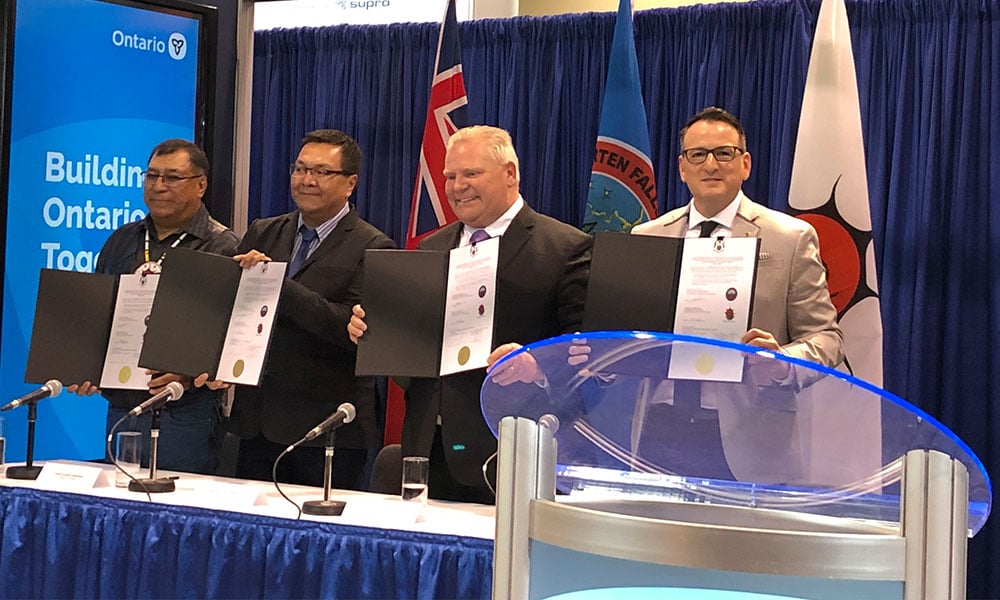
Two of nine Matawa First Nations publicly support Northern Road Link

The Government of Ontario will develop road access in northern Ontario to service First Nations communities and potentially develop the Ring of Fire project, Ontario Premier Doug Ford and Minister Greg Rickford announced on Monday at the Prospectors and Developers Association of Canada's annual convention in Toronto.
Rickford, who is Minister of Energy, Northern Development and Mines, and Minister of Indigenous Affairs, said the road would not only provide access to the Ring of Fire chromite mining and smelting project, but would provide better access to health care and social services to the Matawa First Nations communities in this area of the James Bay lowlands, as well as jobs.
“Today, we are unlocking a multimillion-dollar opportunity,” Ford said. “Together, we can bring jobs and prosperity to communities across the Far North. Promises made, promises kept.”
The access road and the Ring of Fire project have the support of two First Nations communities in the region. Marten Falls First Nation and Webequie First Nation were represented by their chiefs at the announcement that followed a traditional smudging ceremony; a signing ceremony was held afterwards by both chiefs, the premier and the minister.
“Our First Nations are trusted partners,” Ford said, noting that the government also intends to put in place broadband infrastructure to further support and connect the region. In October, the government announced an investment of $30 million in the Matawa broadband project, which will provide modern and scalable telecommunication services to five Matawa First Nations: Nibinamik, Neskantaga, Eabametoong, Marten Falls and Webequie.
The Northern Road Link would run along the North-South Corridor of the proposed Ring of Fire mining site, connecting to the proposed Marten Falls Community Access Road at the south end, and to the proposed Webequie Supply Road at the north.
The Ring of Fire site, located approximately 500 kilometres northeast of Thunder Bay and covering about 5,000 square kilometres, is estimated to have multigenerational potential for chromite production, as well as for nickel, copper and platinum. The chromium extracted from chromite is used in chrome plating and alloying for production of corrosion-resistant superalloys, nichrome and stainless steel.
The government is evidently committed to building the access road and providing the broadband infrastructure regardless of whether the Ring of Fire project comes to fruition. A number of environmental assessments are still underway, said Rickford. And six remaining Matawa First Nations in Treaty 9, plus one First Nation in Robinson-Superior that is not a signatory to this treaty, have not yet given their support.
Currently, five Matawa First Nations are accessible by air and winter road, while the other four are accessible by all-season roads. The combined population of Matawa is over 10,000, according to the Matawa tribal council’s website.
Spending on Ring of Fire exploration to date has totalled more than $278 million, the Ontario government says, and there are currently approximately 13,296 active mining claim units held by 18 companies and individuals, covering approximately 2,127 square kilometres in the Ring of Fire.
The two First Nations that support the access road and the Ring of Fire project hope it will bring economic prosperity to this region rich in minerals but impoverished economically.
At Monday’s press conference, Chief Bruce Achneepineskum of Marten Falls First Nation said it was important that First Nations be “true partners” in the development of their land, and to think ahead for their children and develop the infrastructure they will need.
“There’s a world of opportunity” through partnerships for his own First Nation and for those of his neighbours, Chief Achneepineskum said, also stressing the need to address legal issues pertaining to treaty rights; no legal counsel was afforded when the area’s First Nations signed Treaty 9, he noted.
Under then-premier Kathleen Wynne, Ontario had negotiated a regional framework agreement with all nine Matawa First Nations in 2014, spending more than $20 million in the process, reportedly. By late 2018 the funding had run out, and in August 2019 the current government dissolved the regional framework agreement in favour of reaching individual accords with each of the nine Matawa First Nations.
“Today is an important milestone,” said Chief Cornelius Wabasse of the Webequie First Nation after making his opening remarks in Ojibway. First Nations communities will have a better quality of life, business and lifestyle opportunities with the agreement, which has been “has been a long time in the making” and puts First Nations first, he said.
However, the chief executive officer of the Matawa tribal council cautioned that the memorandum of agreement signed on Monday was but a preliminary step in building the Northern Road Link. Environmental assessments for the road will still need to be conducted, David Paul Achneepineskum told Canadian Lawyer, noting that the federal government recently announced environmental assessments for the James Bay lowland area, beyond the Matawa First Nations territory.
The construction of the road – and other resource development proposed for the area, which will also concern neighbouring communities such as the Attawapiskat and Fort Albany First Nations – will involve consultation with those First Nations as well, he said. “Their interests will be respected as well,” Achneepineskum said in an interview, expressing his understanding of how the government intends to proceed.
“It’s not a completed agreement to build a road,” he added, but “more of a process to undertake a study and environmental assessments.”